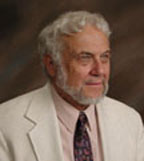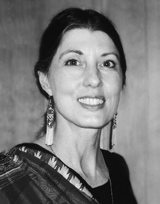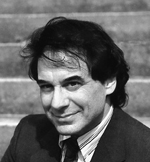By Robert Ellwood
 What will the religion of the sixth and seventh root races be? The seventh'swill no doubt be whatever the religion of a single human megabrain is like, but that gets ahead of the story-one thing at a time. The contours of faith in the sixth root race are now beginning to emerge. Signs abound; the transition appears to be already underway. The twentieth century was a time of great religious change, much of it beneath the surface of exoteric religious institutions.
What will the religion of the sixth and seventh root races be? The seventh'swill no doubt be whatever the religion of a single human megabrain is like, but that gets ahead of the story-one thing at a time. The contours of faith in the sixth root race are now beginning to emerge. Signs abound; the transition appears to be already underway. The twentieth century was a time of great religious change, much of it beneath the surface of exoteric religious institutions.
Although regrettably plenty of iron-hard attitudes remain in the world around religious nationalism and dogmatism, it must be acknowledged that at least the religious "playing field" has changed dramatically since about 1900. Virtually everyone must now recognize that the arguments about religious truth take place in a pluralistic world, and this realization changes our concept of the very nature of belief. A worldview, even a conservative, traditionalist one, must now be seen as a choice made in the face of the possibility of other choices, rather than simply imposed by tradition or authority.
In such an age, an independent organization like the Theosophical Society can have an important role: first, as a paradigm or model of a movement based on the free choice and affiliation of mature members, each in his or her own way; second, as an organization whose teaching affirms the intrinsic value of pluralism as such, recognizing that the knowledge of the Ancient Wisdom each of us has individually is imperfect.
An attitude of respectful pluralism is, in fact, a growing reality at the end of the twentieth century. Even though many people are not yet ready to acknowledge the new reality openly, one can see widespread evidence that religions are actually increasingly regarded as subjective structures that we ourselves construct to negotiate our relation to absolute reality, rather than as objective truths. People change religions freely; they "blend" religions in the increasing number of interreligious marriages and families; they accept that most of the societies of the world are pluralistic ones in which people need to get along with each other. I know of Christian-Jewish families who observe both Christmas and Passover, and Christian-Buddhist families who display both the cross and the image of the Enlightened One in their home.
There are exceptions, but throughout present-day culture, religions are often no longer seen as matters for doctrinal or logical consistency, or for institutional loyalty, as admirable as those virtues may be in some contexts. Instead, they are perceived as invaluable but flexible symbol-systems that maybe employed by individuals in a variety of ways: as instruments of family or community cohesion, as channels for one's aspirations toward the highest realities, as cultural heritages, as inspirations for good living and spirituality, with a dimension of depth.
All the ideas outlined here are very much in line with the Theosophical expectation that we are now moving into the era of the sixth root race, or perhaps more technically, the sixth subrace of the fifth root race, which will prepare for the sixth. We need first to remind ourselves again that the present fifth root race was intended especially to explore and experience the meaning of the material plane. That is its particular role in the course of our long pilgrimage from out of the Halls of Light, which are our true home, for the sake of experience in this and other worlds before our return, enriched and ennobled, to the Source.
For the most part we have done well what we were supposed to do: explore and understand the material composition of the universe. Our science and technology have brought us incomparable knowledge of the laws of nature, of the atom and the galaxy, and of the application of these laws in the making of tools from the flint blade to the computer. There have, of course, been down sides, beginning with the terrible misuse of technology for human exploitation and war, owing to the dismal fact that our moral evolution has hardly kept pace with out scientific progress.
A no less grievous consequence is that the very success of the scientific way of thinking has suggested it as a model of philosophizing in other spheres where its application is more dubious, such as the religious. A master in The Mahatma Letters speaks of our civilization as one which "rests so exclusively upon intellect." Insofar as this applies to religion, it points to the way religion has been seen so much as a matter of dogmas, like scientific axioms or laws, which entail other doctrines with virtually mathematical logic, all of which need to be imposed with the harsh rigor of nature itself.
But this is a very fifth-race way of looking at religion, and not at all the only way possible. The great religions themselves, for all their doctrines, gesture in another direction by holding up conscience, and above all love, as the final court of appeal in the mind and in ethics. If supremacy of conscience means anything, it means that the inner integrity of the individual is more important than any mental construct. If love means anything, it means accepting others in their differences from oneself as well as in their similarities. It says that we want to grow mutually by exploring those differences with appreciation and that this experience of mutuality is deeper and better than just preaching one's dogma at others, take it or leave it.
Increasingly in our world we are coming to see this interactive loving kind of understanding as the way the world ought to be, across religions, castes, races, nationalities, personal differences all areas in which we have laid down many rigid rules as the shadow side of fifth-root-race thinking, with its scientific or pseudoscientific logic. In the sixth root race our calling will not be to pursue some one way with exclusive consistency, but to expand our capacity for love by embracing persons of all kinds and to explore their inwardness with sensitivity and appreciation. Along with this, will come an appropriate recovery of psychic and mystical capacities, the necessary tools for truly profound understanding of ourselves and of that which is beyond ourselves.
There will still be problems, of course, for the sixth root race is not the end of the journey, and some issues, perhaps unimaginable to us now, will remain to be resolved in the seventh or on other worlds. One is fairly familiar: how does one respond in love to another whose way of life one honestly believes to contain evil? Other issues may be a little further down the road: do the coming biological engineering and neurotechnological techniques mean enhanced human freedom, or do they only invite totalitarian control of whatever is left of the individual? It seems clear that the world is now making the transition to new kinds of thinking that spell a new stage in evolution, and before long the remaining moral and ethical issues will be dealt with in fresh ways.
This is how I see the coming sixth root race: a people of pluralism, individuality, new ways of image-based reading and thinking, leading up to an amalgamation of all those relatively enlightened individual humans into what is really a transhuman stage, the neuro technological linkage of all minds into a grand array of consciousness. That united supermind will be the seventh rootrace, the last which will have need at all for this physical world and which we hope will live on a spiritual level appropriate to its tremendous leap into cosmic consciousness.
What signs are pointing to that unimaginable future, and what is the shape of that which comes? First let us consider future scenarios from the scientific sphere. The distinguished physicist and master of scientific speculation Freeman Dyson has suggested, in Imagined Worlds, an awesome list of awaiting technological revolutions. From our point of view, these will be material concomitants and expressions of the changing consciousness and spirituality of the sixth root race. First, genetic engineering, already commenced but still ata very crude level, within two or three centuries will produce biological entities virtually on demand, including Jurassic Park animals, plus new and improved human bodies, to reflect the undogmatic plasticity of sixth-root-race consciousness.
One of the most dramatic prospects awaiting us in biological engineering will call for new thought patterns and new religious concepts. Sooner than we now think, it may be possible to reverse the aging process through cellular modification or transplants and so create immunity to most of the ailments from which we die. This would result in very long life spans of hundreds or even thousands of years, indeed perhaps virtual immortality.
One can only begin to conjecture what kind of effect this development would have on the world's religions, since they now exist in large part as guides for how to live within a very limited span of years and in the face of mortality, and include strong elements of hope and fear regarding the afterlife. Remove the specter of the man with the scythe more or less indefinitely and, if religion as we know it does not simply wither away, other features of faith than those centering around death will no doubt gain prominence, ones that some of us might consider healthier concerns: community, ethics, and the spiritual quality of life.
But even virtual immortality is as nothing compared to the prospects lurking within the emerging science of neurotechnology. The premier art of that field, splicing biological beings with computerized intelligence (miniaturized and flexible far beyond present capability), will then be ready to equip the new man and woman with remarkable combinations of human mind and artificial intelligence. Dyson among others has suggested that before long we may be able to download data and ideas directly from computers to our brains, and from brains to databases. Perhaps the computers themselves would be organic and, as it were, grafted-on brain-enhancing body parts.
Then as the third radical development after virtual immortality and neuro-computer linkages, it will be possible to transmit data by what Dyson calls radio telepathy, "brain waves" or neuron charges translated by a small implanted sender into radio waves that could be picked up by a computer receiver or by another brain. Radio telepathy will allow all these enhanced minds to be directly linked like computer arrays on the level of memory, thought, and will. This vast human computer array could be moving into place by the end of the next millennium, in a thousand years or less.
Radio telepathy could be achieved either through tiny transmitters placed in the brain or through the genetic engineering of cerebral biology to electrify, computerize, and "radioize" the human brain, on the model of the electric organs that already exist in electric eels and electric catfish. It would then permit the direct communication of signals and information from one brain to another, and no doubt also from associated computerized databases. Books, videos, spoken language, and other primitive means of transmitting information through verbal symbols encoded on paper or film or in combinations of sound waves, and received by means of the senses, will then be as outdated as those bards who, before the invention of writing, had to commit vast amounts of tribal lore to memory.
Radio telepathy, whether from data bases to brain or from brain to brain, would certainly be as revolutionary an advance in communication, and even in the human meaning of knowledge, as was the invention of writing, which those powerful new information engines will displace. It would deliver to us a world as different from the age of literacy as that age was from the preliterate stone-age world that went before. At best, reading, writing, and speaking would now be used only for historical, recreational, or aesthetic purposes. Another thought: it might also be possible by this means, Dyson suggests, to connect with the minds of other species and for the first time to know directly the subjective world of a cat, a dog, an eagle, or a dolphin.
From here only a small step will carry us to the most revolutionary development of all, one that we might wish to term the seventh root race. The next stage,though dramatic and irreversible, would be comparatively easy after radio telepathy, and probably would not be long resisted, though it would mean nothing less than changing human beings as we know ourselves into something that is not merely another species, or another genera, but virtually a whole new order of life.
For a thousand years from now or perhaps sooner, undoubtedly it will be possible to unite those radio telepathically implanted brains into great arrays of tens,hundreds, even thousands of units capable of problem-solving and achievement not to mention pleasure on an unimaginable scale. But within a collective like this,one imagines the individual, and with it individual consciousness, fading and failing in the face of the vastly larger collective mind's power.
One can project vast disquietude by humans in the immediate face of this prospect, but it would not be resisted long. The newest and most powerful technology never is, and the competitive edge going to those accessing large-array brains would make this neurological leap imperative for the rest. Nonetheless this awesome change in human nature would clearly overturn all existing institutions. The profoundest challenge of this eventuality, as in the case of biological individual immortality, would be to religion, whatever form it has taken a millennium from now. For religion as we know it depends fundamentally on the idea of the responsible individual self, and the self would now be shown to be outdated, a puny instrument in the eyes of something immensely greater.
Death would indeed no longer have its sting nor the grave its victory, at least not to the collective consciousness, which will increasingly simply be the consciousness of each entity within its hold. The whole would undoubtedly soon,and irreversibly, supplant individual human consciousness like a far more powerful radio signal drowning out lesser stations. Its mental energies, its brilliance of intellect, its determined will and purpose, its breadth of information and awareness, its inconceivable joys and raptures, will dwarf anything we, or rather our distant progeny, could possibly sustain on our own, and we, or they, would become it. So it is that the entire part of religion that deals with individual preparation for death, the trauma of dying, final judgment, and immortality or resurrection will retain little meaning.
And what is the spiritual status of a radio telepathically-linked collective mind? Is it itself a person in the religious sense, a soul, capable of sin and salvation, or of karma and enlightenment the great idea of axial-age, fifth-root-race religion? Or is the new human megabrain a demonic entity that has swallowed up the greatest of God's creations, the individual soul? Or can souls somehow still be found within it? At our present level of consciousness, these questions are simply unanswerable.
Nor is that all. For the collective, for all intents and purposes, would be immortal, at least until the collapse and death of this particular universe eighty billion years hence and by then the array, perhaps by now united into one vast universal consciousness of billions of parts, could be a mind invincible enough to prevail even against that ultimate termination. Life and death will be as insignificant to the collective as the individual. Any one unit within it, upon failing, would easily be replaced by another, no doubt quickly constructed for the purpose by biological engineering.
It can be argued, of course, and probably will be at the time, that religion has other foci than the separate individual, indeed that it insists the separate individual is not the ultimate focus of meaning. In Christianity, individuals are supposed to be parts of the body of Christ, like cells or organs in a physical body, almost like a spiritual anticipation of the collective. The Hindu social order, with its castes and roles, is based on an organic more than an individualistic model of society. Priests and preachers will endeavor to spiritualize the collective in some such manner as this. Yet to see the spiritual ideal become everyday physical and biological reality will be no small challenge to conventional religion. How can Theosophy respond to this and the other challenges of the occult future?
We have a couple of hints about Theosophy and this "science fiction" future in a classic Theosophical text. The Mahatma Letters to A. P. Sinnett (letter 66 in the chronological edition, 14 in the third edition, part 7b) tell us: "The principle of acceleration and retardation applies itself in such a way, as to .. . leave but a single superior one [stock] to make the last ring." As the text makes clear, this final superior entity is also the culmination of the seventh root race. And (letter 93B, 23B): "The last seventh race will have its Buddha as every one of the predecessors had; but its adepts will be far higher than any of the present race, for among them will abide the future Planetary, the Dhyan Chohan" or meditation buddha, whose contemplative aura can embrace a planet and who will instruct the next still higher level of development that will pass beyond our world altogether.
One can easily imagine that, at this level, those other adepts and that superior stock would harmoniously and without coercion be embraced within the Dhyan Chohan's single incomparable mind. These no doubt partial and tentative glimpses into the distant spiritual future, couched in traditional language and concepts,hint at one important idea: that the separate individual human self as we now know it is far from the final stage of spiritual evolution. At higher and higher levels, both selection and increasing harmony in freedom will move us together toward a single transcendent consciousness capable of almost unimaginable wisdom, power, and bliss. In that buddhic mind, consciousness and all experience will be united and fulfilled in a way that is now only potential and barely felt by most.
If these developments include the use of technological, or neuro technological, innovations as well as purely "spiritual" means of evolution, that should not surprise us nor discredit the advance. Theosophy has never imposed a rigid dualism between the sprit and the flesh, or the spiritual and the technological,but rather accepts, with the Mahatmas of the Letters, that manifest reality isin fact all material as well as spiritual. Matter, however, is capable of higher and subtler refinements than most of us can conceive and is susceptible to scientific and technological as well as subjective means of evolution.
Matter and spirit express each other, and to set them in opposition is a false dualism. We are material and are meant to use matter as we continue our evolution, letting its deep interplay with consciousness direct us toward the spiritual values of oneness and love. But we are also creatures of free will, and so able to abuse anything. The sixth-root-race values of tolerance and the seventh of oneness of consciousness could of course lead to subtle kinds of evil magic. But they need not.
From the point of view of the tremendous overall Theosophical model of spiritual evolution, we can be optimistic about the future. We can and must believe that the new spiritual energies which are released into the world with each upward movement, and which are being powerfully released now despite often discouraging appearances, have the power to overcome the negatives and bring us closer to the Halls of Light. Ultimately, they will. If we work with them with selflessness and wisdom, they will raise us quickly and easily. If not, the job will take longer and will be much harder.
For us as Theosophists, then, I offer two reflections. First, we must not think that we are outdated or irrelevant in this rapidly changing world, as I am sure we are sometimes tempted to think. I am convinced that the deepest relevance of the Theosophical message is only beginning to be apparent, that we are among those who really know what is going on, both historically and spiritually, and we are desperately needed to put it in the largest possible perspective.
Second, the task does not call for arrogance, but more love and service, our great ideal virtues, with a bit of upaya, skill-in-means, thrown in. As new languages, new thoughts, new worlds arrive, we must be there at the cutting edge of change, expressing Theosophy in fresh media, showing that any emergent era is ours in the sense that we have equipment for understanding it and shaping it to the right ends of human freedom and brotherhood, rather than giving over to those dark forces that would make new developments only novel means of enslavement.
How this is done will be up to the now-young generation of Theosophists. But the next stage of human evolution may not wait much longer than that before commencing radically to remake our human world. We must all be, in the familiar title from the Adyar Theosophist, "on the watchtower."
Robert Ellwood, a noted authority in the history of religion, is the author of many works of scholarship, including Alternative Altars: Unconventional and Eastern Spirituality in America (University of Chicago Press) and The Politics of Myth: A Study of C. G. Jung, Mircea Eliade, and Joseph Campbell (StateUniversity of New York Press). He is also the author of several Quest Books: The Cross and the Grail: Esoteric Christianity for the 21st Century, Finding the Quiet Mind, The Pilgrim Self, and Theosophy. He has long had a love of science fiction and speculative science, as well as amateur astronomy.
 Helena Petrovna Blavatsky, the main idea-person and one of the principal founders of the Theosophical Society, is often criticized because she was not known as an ascetic or model of spiritual purity. Yet the Mahatmas themselves tell us that she was "the best available" to create a bridge between East and West although they had searched for a hundred years to find a suitable person. From this information, we conclude that her personality flaws are what make her less than ideal as the leading spokesperson for the Theosophical Society. In that conclusion, I wonder, however, "Are we missing the point?"
Helena Petrovna Blavatsky, the main idea-person and one of the principal founders of the Theosophical Society, is often criticized because she was not known as an ascetic or model of spiritual purity. Yet the Mahatmas themselves tell us that she was "the best available" to create a bridge between East and West although they had searched for a hundred years to find a suitable person. From this information, we conclude that her personality flaws are what make her less than ideal as the leading spokesperson for the Theosophical Society. In that conclusion, I wonder, however, "Are we missing the point?"

 Excitement filled the air when more than 500 members from 39 different countries attended the Ninth World Congress of the Theosophical Society, held in Sydney, Australia, January 11 -18, 2001. Long-time friends and new ones among the many cultures represented at the Congress forged the bonds of brotherhood that cross all cultural boundaries. All were struck by our similarities, interest in the same studies, and concerns over the same issues.
Excitement filled the air when more than 500 members from 39 different countries attended the Ninth World Congress of the Theosophical Society, held in Sydney, Australia, January 11 -18, 2001. Long-time friends and new ones among the many cultures represented at the Congress forged the bonds of brotherhood that cross all cultural boundaries. All were struck by our similarities, interest in the same studies, and concerns over the same issues. I am walking like Bugs Bunny walked when he walked behind Elmer Fudd, mimicking Fudd's hunting him. I am doing this amidst a dozen strangers outside a classroom of the Krotona Institute, high on a hill overlooking southern California's Ojai valley. I'm in my stocking feet, and one foot goes down very deliberately to a silent chord of three seconds while the other balances precariously in the air. It doesn't matter how funny I look with my Fudd-Bunny impersonation because each of my classmates is equally intent upon their own deliberate gait and posture. It's a focusing exercise; and when I don't feel like Bunny, I feel like a Cherokee, imagining my moccasins ever so gently touching the earth. I think I can feel the wobble of the earth and I seem to hear the song it sings in the hot dry breath of the cypresses undulating like waves to the Topa Topa ranges.
I am walking like Bugs Bunny walked when he walked behind Elmer Fudd, mimicking Fudd's hunting him. I am doing this amidst a dozen strangers outside a classroom of the Krotona Institute, high on a hill overlooking southern California's Ojai valley. I'm in my stocking feet, and one foot goes down very deliberately to a silent chord of three seconds while the other balances precariously in the air. It doesn't matter how funny I look with my Fudd-Bunny impersonation because each of my classmates is equally intent upon their own deliberate gait and posture. It's a focusing exercise; and when I don't feel like Bunny, I feel like a Cherokee, imagining my moccasins ever so gently touching the earth. I think I can feel the wobble of the earth and I seem to hear the song it sings in the hot dry breath of the cypresses undulating like waves to the Topa Topa ranges. What will the religion of the sixth and seventh root races be? The seventh'swill no doubt be whatever the religion of a single human megabrain is like, but that gets ahead of the story-one thing at a time. The contours of faith in the sixth root race are now beginning to emerge. Signs abound; the transition appears to be already underway. The twentieth century was a time of great religious change, much of it beneath the surface of exoteric religious institutions.
What will the religion of the sixth and seventh root races be? The seventh'swill no doubt be whatever the religion of a single human megabrain is like, but that gets ahead of the story-one thing at a time. The contours of faith in the sixth root race are now beginning to emerge. Signs abound; the transition appears to be already underway. The twentieth century was a time of great religious change, much of it beneath the surface of exoteric religious institutions.